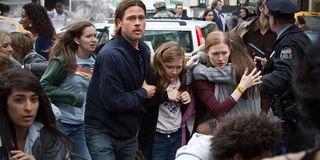Why You'll Never See World War Z's Original Ending

There were better blockbusters released in theaters this summer, but maybe none as fascinating as World War Z, which looked like a complete catastrophe until it opened to a surprise $66 million and reviews that seemed positive almost despite themselves. Much of the credit went to the film's new ending, which was totally rewritten by Damon Lindelof and Drew Goddard to be a tense interior scene as opposed to yet another battle scene. Marc Forster, who had reportedly feuded with Brad Pitt, was seen as the guy from whom the movie had to be rescued. But now the director is finally giving his side of the story on the film, and those changes that rescued the finale.
"Basically in the original ending, after the Israel sequence and the plane crash, Gerry is in Russia, and the storyline of what he finds out at the WHO lab is what he finds in Russia but he applies his theory in a battlefield setting," Forster explained to Movies.com ahead of the film's release this week on Blu-ray. " We never finished that footage because we all agreed after Israel and the plane crash you’re battle fatigued and you really want the movie to be more quiet and you don’t want it to go into another huge combat situation" As Forster points out, some of the Russian battle sequence can be seen in the quick montage at the end of the film, but the complete sequence will never be seen. "I don’t think you’ll ever see the Russia sequence, because we never really finished it; we never spent the money to do the visual effects. Once we shot it and we did a rough cut, everyone agreed that this is too big and too exhausting, it would be better to go a simpler route."
Apparently ready to let bygones to be bygones, Forster also gets into detail on the film's actual ending, when Brad Pitt's character Gerry gets up close and personal with a zombie in the abandoned wing of the WHO headquarters in Wales:
“It was very important for me to first cast the actor who would play that zombie [that Gerry confronts in the lab]. His name is Michael Jenn. He’s a performer and had all these different skills, but the key thing with me was to make you feel with this zombie this mirror that this used to be a human. We hadn’t had that moment in the film, this loss of humanity. I put a wedding ring on his finger and he’s banging it very subtly against the glass door. So to give this man a history that he was married, he had a life at one point."
That tense moment between Gerry and the zombie, and the entire suspenseful sequence inside the WHO office, is much more like a traditional zombie film, in which there isn't the budget to stage the kind of massive action sequences that World War Z thrived on. But that slamming on the brakes, and allowing Gerry to become a hero in a quiet setting, really did rescue the movie. Watching teeming piles of zombies overwhelm Philadelphia and Israel became exhausting well before Forster admitted it did, and especially given how chaotically he edited all of the action sequences, the idea of yet another one-- at night, no less-- would be horrifying. Who knows how Forster came to recognize that what he did with the final sequence didn't work, but kudos to him for being willing to go small-- and now talking about it as if it was all totally fine with him, whether it really was or not.
You can catch World War Z, though not that famously scrapped ending, on Blu-ray this week.
CINEMABLEND NEWSLETTER
Your Daily Blend of Entertainment News
Staff Writer at CinemaBlend
Most Popular





